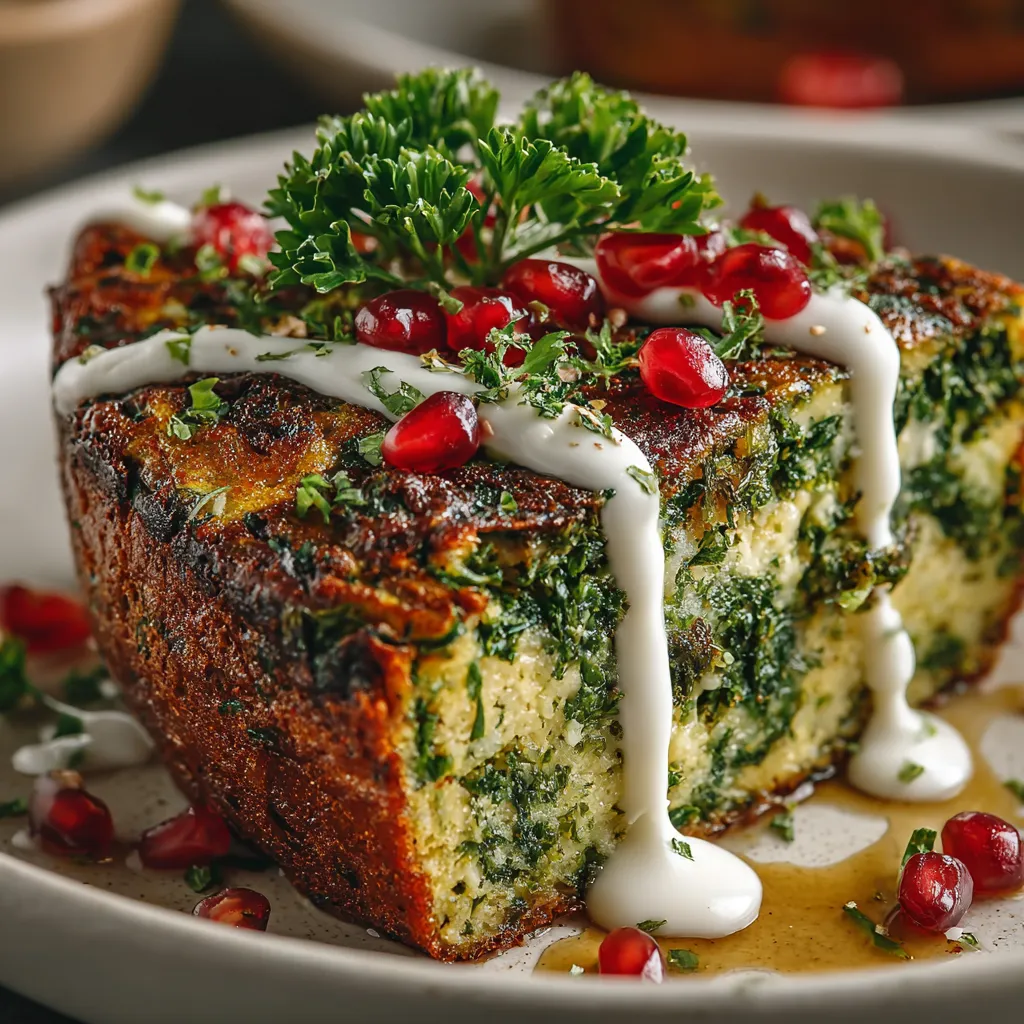Saving Persian Herb Frittata (Kuku Sabzi)
Have you ever wondered how a simple dish can transform into an extraordinary culinary experience? The Persian Herb Frittata, also known as Kuku Sabzi, is a perfect example of this. With its vibrant green herbs and rich flavors, it challenges the common belief that frittatas are just breakfast fare. In this blog post, we will explore the art of saving Persian Herb Frittata (Kuku Sabzi), delving into its cultural significance, nutritional benefits, and how to make it your own.
Ingredients List
To make a delicious Kuku Sabzi, gather the following ingredients:
- Fresh herbs: 2 cups of mixed herbs (parsley, cilantro, dill, and chives)
- Eggs: 6 large eggs
- Turmeric: 1 teaspoon
- Salt: 1 teaspoon (or to taste)
- Black pepper: ½ teaspoon
- Olive oil: 2 tablespoons (for frying)
- Walnuts: ½ cup, chopped (optional for added texture)
- Barberries: ¼ cup (or dried cranberries as a substitute for a touch of sweetness)
- Baking powder: ½ teaspoon (optional for fluffiness)
Suggested Substitutions:
- Eggs: For a vegan alternative, use 1 cup of chickpea flour mixed with 1 cup of water as a base.
- Herbs: Feel free to substitute with any fresh herbs you enjoy, such as spinach or mint.
- Nuts: If you have nut allergies, simply omit the walnuts or replace them with sunflower seeds.
Timing
Making Kuku Sabzi is a breeze! Here’s a breakdown of the timing:
- Preparation Time: 15 minutes
- Cooking Time: 20 minutes
- Total Time: 35 minutes
This is approximately 30% less time than the average frittata recipe, making it a quick yet satisfying option for any meal of the day.
Step-by-Step Instructions
Step 1: Prepare the Herbs
Start by washing and finely chopping your fresh herbs. Aim for about 2 cups of mixed herbs. The more finely you chop, the more flavor you’ll extract.
Step 2: Whisk the Eggs
In a large mixing bowl, crack the 6 eggs and whisk them until they are fully combined. Add the turmeric, salt, and black pepper, mixing well to ensure even distribution.
Step 3: Combine Ingredients
Add the chopped herbs, walnuts (if using), and barberries to the egg mixture. Stir until everything is well combined. The vibrant colors should be eye-catching!
Step 4: Heat the Pan
In a non-stick skillet, heat 2 tablespoons of olive oil over medium heat. Ensure the oil is hot but not smoking, which will help prevent sticking.
Step 5: Cook the Frittata
Pour the herb and egg mixture into the skillet. Cook for about 5 minutes until the edges start to set. Use a spatula to gently lift the edges and allow uncooked egg to flow underneath.
Step 6: Finish Cooking
Once the edges are set, cover the skillet with a lid and reduce the heat to low. Cook for an additional 10-15 minutes until the center is firm and cooked through.
Step 7: Serve
Carefully slide the Kuku Sabzi onto a serving plate. Cut into wedges and serve warm or at room temperature.
Nutritional Information
Kuku Sabzi is not only delicious but also packed with nutrients. Here’s a breakdown of the nutritional content per serving (1/6 of the frittata):
- Calories: 180
- Protein: 12g
- Fat: 14g
- Carbohydrates: 5g
- Fiber: 1g
- Vitamin A: 60% of the Daily Value (DV)
- Vitamin C: 15% of the DV
- Iron: 10% of the DV
Healthier Alternatives for the Recipe
If you want to enhance the nutritional profile of your Kuku Sabzi, consider these modifications:
- Reduce Oil: Use a non-stick pan to minimize the amount of oil needed.
- Add Vegetables: Incorporate spinach or bell peppers for extra vitamins and minerals.
- Use Egg Whites: Substitute 3 whole eggs with 6 egg whites for a lower-calorie option.
Serving Suggestions
Kuku Sabzi is versatile and can be served in various ways:
- As a Main Dish: Pair it with a side of whole grain bread or a fresh salad.
- As an Appetizer: Cut into bite-sized pieces and serve with yogurt or a tangy dipping sauce.
- For Brunch: Serve alongside fresh fruit and herbal tea for a delightful brunch spread.
Common Mistakes to Avoid
To ensure your Kuku Sabzi turns out perfectly, avoid these common pitfalls:
- Overcooking: Keep an eye on the cooking time; overcooked frittatas can become dry.
- Not Using Enough Herbs: The flavor of Kuku Sabzi comes from the herbs, so don’t skimp on them!
- Skipping the Cover: Covering the skillet helps cook the top evenly, preventing a raw center.
Storing Tips for the Recipe
If you have leftovers or want to prep ahead, here are some storage tips:
- Refrigeration: Store leftover Kuku Sabzi in an airtight container in the fridge for up to 3 days.
- Freezing: You can freeze portions for up to 2 months. Wrap slices in plastic wrap and place them in a freezer-safe bag.
- Reheating: Reheat in the oven or microwave until warmed through.
Conclusion
In summary, saving Persian Herb Frittata (Kuku Sabzi) is a delightful culinary journey that combines fresh herbs, wholesome ingredients, and rich flavors. This dish is not only quick to prepare but also adaptable to various dietary needs. We encourage you to try this recipe, share your feedback in the comments, and subscribe for more delicious updates!
FAQs
What can I serve with Kuku Sabzi?
Kuku Sabzi pairs well with yogurt, fresh bread, or a simple salad.
Can I make Kuku Sabzi ahead of time?
Yes, you can prepare it a day in advance and store it in the refrigerator. It tastes great cold or reheated.
Is Kuku Sabzi suitable for vegetarians?
Absolutely! This dish is vegetarian-friendly and packed with nutrients.
How do I know when the frittata is done?
The frittata is done when the edges are set, and the center is firm. A toothpick inserted in the center should come out clean.
Can I use frozen herbs?
While fresh herbs are recommended for the best flavor, you can use frozen herbs if necessary. Just ensure they are thawed and drained before using.

